 There are few choices that are exclusively correct. I believe the expression was “There are more ways than one to skin a cat” before political correctness and text messaging removed it and two thirds of our cultural vocabulary. What follows is not a suggestion regarding the choice of sights for a firearm, but rather a recounting of a week of my life spent selecting and changing parts and shooting, then hammering a bit and shooting some more. As a gun geek, very exciting stuff… Really.
There are few choices that are exclusively correct. I believe the expression was “There are more ways than one to skin a cat” before political correctness and text messaging removed it and two thirds of our cultural vocabulary. What follows is not a suggestion regarding the choice of sights for a firearm, but rather a recounting of a week of my life spent selecting and changing parts and shooting, then hammering a bit and shooting some more. As a gun geek, very exciting stuff… Really.
The project began with a Marlin 1894 Deluxe; a nifty little gun, chambered for the 44 Remington Magnum. It has just a little touch of “fancy” in its walnut stock and deep blued finish, but not so much as to keep it locked up in a vault. The only problem encountered when initially shooting the rifle was looking through its traditional semi-buckhorn rear and bead front sights with my less than eagle sharp eyes. I could feel the sights, I just couldn’t see them… particularly that one way out front.
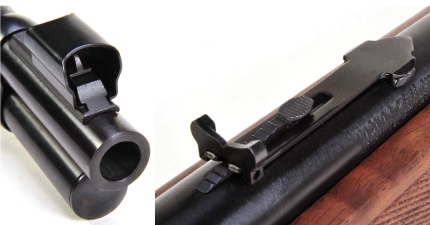
As open sights go, the Marlin’s sights are good. The face of the front sight has a stand out brass finish, a hood protects the sight and helps centering on target. The rear sight is adjustable for elevation and can be adjusted for windage by drifting it left or right in its dovetail mount.
The typical limitation with sights of this type is that while their apparent size remains constant, the target’s apparent size decreases with distance until, eventually, a deer can hide behind the blade of some front sights. The other shortfall is that black or dark-colored front or rear sights tend to get lost against dark backgrounds. Since my intention was to shoot this gun frequently, I went shopping for enhanced sights.
Dovetail Style FireSights

Williams Dovetail Style FireSights, Brownells # 962-602-170, are made to fit a wide variety of Winchester and Marlin centerfire lever action rifles. The rear sight is made of aluminum, the front sight insert is steel. The rear sight is adjustable for both windage and elevation. The two dots are formed by the ends of a “U” shaped 0.057″ diameter, light gathering, green fiber optic, also termed a light pipe or light guide. The rear sight notch is 0.080″.
The front sight insert is 0.312″ high, measured from the base of the dovetail to the top of the sight, 0.250″ above the surface of the front ramp. That makes it the same height as the factory 1894 front sight. The red fiber optic insert is 0.057″ in diameter.
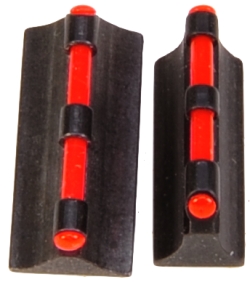 The Williams front sight insert included with the set was too wide and too long for the 1894 Marlin to be a clean fit. FireSight inserts are made with a standard 3/8″ dovetail in widths of “N” (0.250″), “M” (0.340″) and “W” (0.531″). The Williams Dovetail Set includes an “M” insert, however, an “N” width is a much better for the Marlin 1894’s front ramp. I could have used the Williams insert as received or retained the factory insert, but I wanted the pieces to fit right and the benefits of the light gathering fiber optics, so I installed an “N” insert, Brownells # 962-564-340, 0.312″ high.
The Williams front sight insert included with the set was too wide and too long for the 1894 Marlin to be a clean fit. FireSight inserts are made with a standard 3/8″ dovetail in widths of “N” (0.250″), “M” (0.340″) and “W” (0.531″). The Williams Dovetail Set includes an “M” insert, however, an “N” width is a much better for the Marlin 1894’s front ramp. I could have used the Williams insert as received or retained the factory insert, but I wanted the pieces to fit right and the benefits of the light gathering fiber optics, so I installed an “N” insert, Brownells # 962-564-340, 0.312″ high.
As noted previously, the Dovetail FireSight is made for use on a variety of Winchester and Marlin lever guns. There should be the expectation that inserts may have to be juggled to accommodate not only the mechanical fit of the insert, but to adjust the point of impact to accommodate a particular combination of rifle and ammunition. As an example, with the Model 1894’s 16″ sight radius it takes +/- 0.009″ change in front sight height to vertically shift point of impact 1″ at 50 yards. Over time I’ve accumulated a selection of front sight inserts for use with Winchester and Marlin rifle, so I just change them out as needed to accommodate the particular rifle. This number stamped on the bottom of the dovetail represents the last two digits of the manufacturer’s part number, which is not typically an indication of the sight height.
Ghost Ring FireSight… a little experimentation
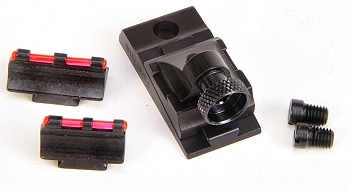
The WGRS-336 set, Brownells# 962-000-058 and WGRS-336, rear sight Brownells# 962-000-019, are intended for use on the Marlin 336. Fully adjustable and supplied with a 3/8″x0.093″ aperture, they are listed by Williams as a ghost sight. Removing the aperture leaves a 0.178″ opening, and the whole line of Williams apertures fit; 0.050″ to 0.150″. This sight matches the scope base hole spacing on all modern centerfire lever action Marlins.

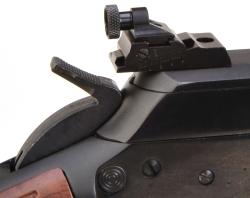 The Model 336, compared to the Model 1895 is a bit like long action versus short action. The Marlin 336, above top, has rear scope base mount holes located 0.500″ farther forward than the Model 1894. Additionally, where the scope mount holes, aft and forward, are 3.250″ center to center on the Model 336, they are only 2.375″ center to center on the Model 1894.
The Model 336, compared to the Model 1895 is a bit like long action versus short action. The Marlin 336, above top, has rear scope base mount holes located 0.500″ farther forward than the Model 1894. Additionally, where the scope mount holes, aft and forward, are 3.250″ center to center on the Model 336, they are only 2.375″ center to center on the Model 1894.
Mounting the WGRS-336 sight in the Model 1894 aft scope base location clearly is not meant to be. Even if I were one of those guys who replaces a missing lever pivot screw with a piece of string and would mount the sight this way, the sight would gets in the way of the hammer. Taking a tip from my innovative MILSURP brothers who routinely barrel mount peep sights…
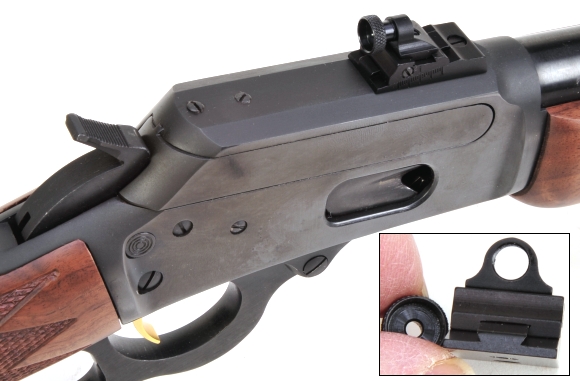
I tried shooting with the WGRS-336 installed in the forward scope base mount holes of the Model 1894, exactly 2″ farther forward than the Model 336 – 16.25″ from the recoil pad rather than 14.25″ and the sight picture was actually very good. In doing a little investigating, I found the Williams peep sight set for the ’96 Mauser that mounts in place of the issue sight ends up being 22″ ahead of that gun’s butt plate and is supplied with a 0.150″ aperture, an accommodation to apparent size diminishing with distance. I settled on a 0.125″ aperture and found an ideal sight picture; centering, but not obstructing. The WGRS-336 is supplied with two front sight inserts, one “M” and one “N”, both 0.450″ high. The increase in height over the standard 0.312″ insert is intended to accommodate the increased height of the WGRS-336 aperture over the factory piece. The insert height change is generally required to get full range of elevation adjustment out of the set.
Foolproof receiver sights… Sounds like a challenge
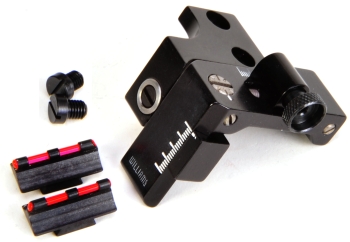
Foolproof receiver sights, Brownells #962-200-002 for the rear sight and #962-000-059 for the FireSight type set, are micro adjustable sights. Made of anodized aluminum, the FP series sight features interchangeable apertures and optional oversize target knobs. The adjustments are micrometer type, approximately 1/4 MOA per full turn. Both elevation and windage adjustments are locked with set screws when adjustment has been completed.
The set comes with “M” and “N” 0.312″ high front sight inserts, with the “N” being correct for the Marlin’s narrow front ramp. The Foolproof sight is very low profile, approximately 0.200″ lower than Williams’ ghost ring sight so the front sight insert is about the same as the Marlin’s factory piece. The issue of mounting with this set is the same as with the ghost sight. The Foolproof 336 is intended for the longer action Marlin 336 rifles so there is inadequate support for the sight when mounted to the aft scope mount holes and an offset hammer spur will not create reasonable hammer clearance.
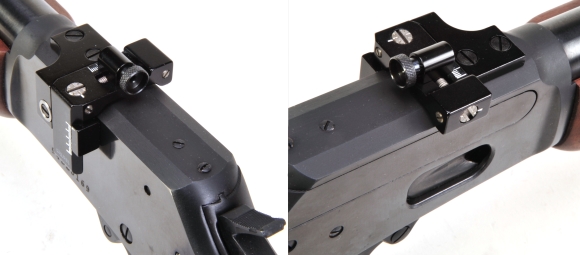
The sight worked out well, accuracy was good and adjustments were precise. I had to change to a 0.125″ aperture for best results. The only other component changed was the substitution of a radiused front sight hood from one of my early Marlins in place of the wide hood that is supplied with current models. The current hood tended to clip the receiver sight image to the point it was a little distracting, My next step will be to replace the hood with a Pre- ’64 Winchester Model 70 hood, Brownells #344-000-008. It is radiused and approximately 0.250″ higher than the Marlin radiused hood, which should help form concentric rings for an improved sight picture. There is always the option, of course, of just removing the hood when using the peep sight.
Could be the Marlin, the sights… or my 2x reading glasses
I knew, as I worked my way through the sight sets previously noted. that group sizes were getting progressively smaller with each change, but I didn’t know if I was getting close to the gun’s potential or, perhaps, my metallic sight shooter’s limitations. It was time to install a scope to get a better understanding what could be expected of the Marlin 1894.
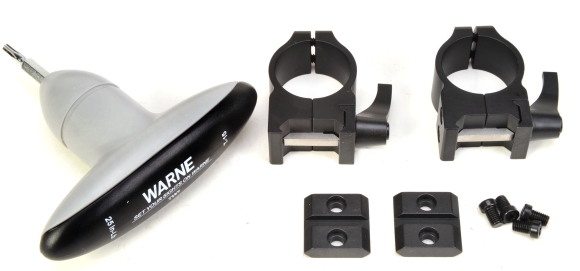
XS makes a rail mount for the 1984 that would have been a more practical choice for this rifle since it provides many ring placement options, which means a lot more latitude when selecting a scope with a workable tube length – Brownells# 006-000-170. However, I have a similar system on my Guide Gun and I am always left with the impression that I’m looking down the back of a crocodile and the Marlin 1894 was just too pretty to turn into a quasi lever action assault rifle… at least for now. So I went with the Warne tools and parts pictured above.
The Warne Scope Ring Torque Wrench is a low cost and handy solution to get to 25 in. lbs. required for scope ring and base hardware. In checking the consistency of applied torque, the difference between this tool and my adjustable in. lb. torque wrench was negligible. Since most scope mounting hardware works to the same torque spec, this is a useful bench tool. The bases selected are Warne Maxima symmetrical 2 piece steel, Brownells # 947-000-168. The quick release, cross locking, medium height, 1″ steel rings are Brownells # 947-623-100.

Since no CAS members threw bricks at me while shooting at the range, there is the suggestion that too many rules of nature weren’t violated by hanging a compact scope on the 1894.
Are those Internet or actual inches?
These fifty yard, three shot groups were shot from a bench with handloads intended for recreational target shooting. Regardless the sights in use, this gun made me wonder what happened to the good old days of deer-friendly lever action rifles and five inch fifty yard groups.
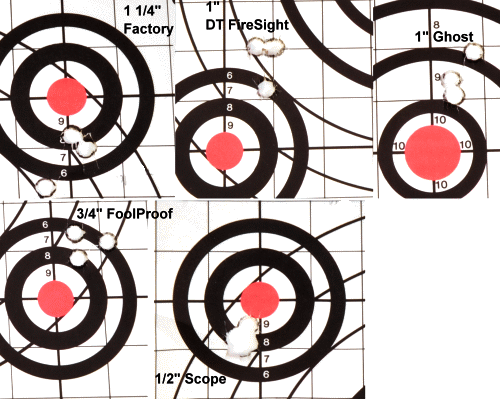
Of the metallic sights, the Foolproof peep sight yielded the tightest group size and was the easiest aperture sight within this group to get on target. Adjustment was precise and predictable. The Dovetail FireSights had the best visibility of all. The fiber optic dots pick up lots of light and standout against dark and mottled backgrounds. The ghost sights were fine, just not exceptional in any particular way. They shot about the same as the Dovetail FireSights and they were slower to get on target. The compact scope really helped the rifle’s performance. Providing an offset to my eyesight deficiencies, not only did it allow the rifle to perform well at fifty yards, it made the Marlin, comfortably, a hundred yard rifle. Nice to have so many good options.

Email Notification